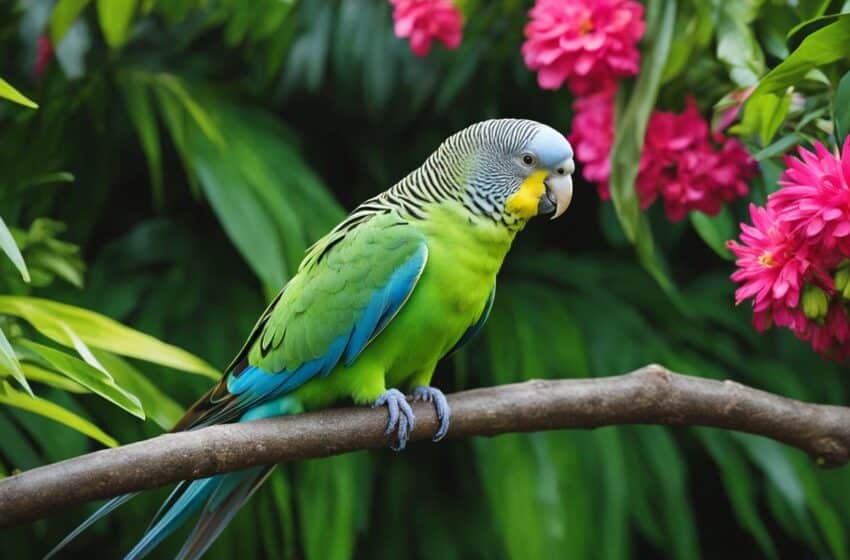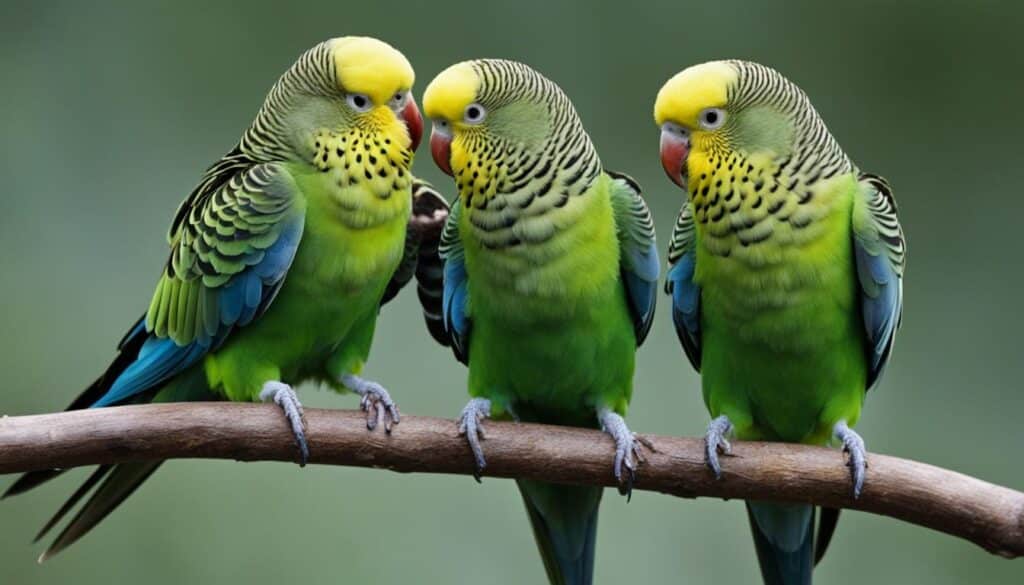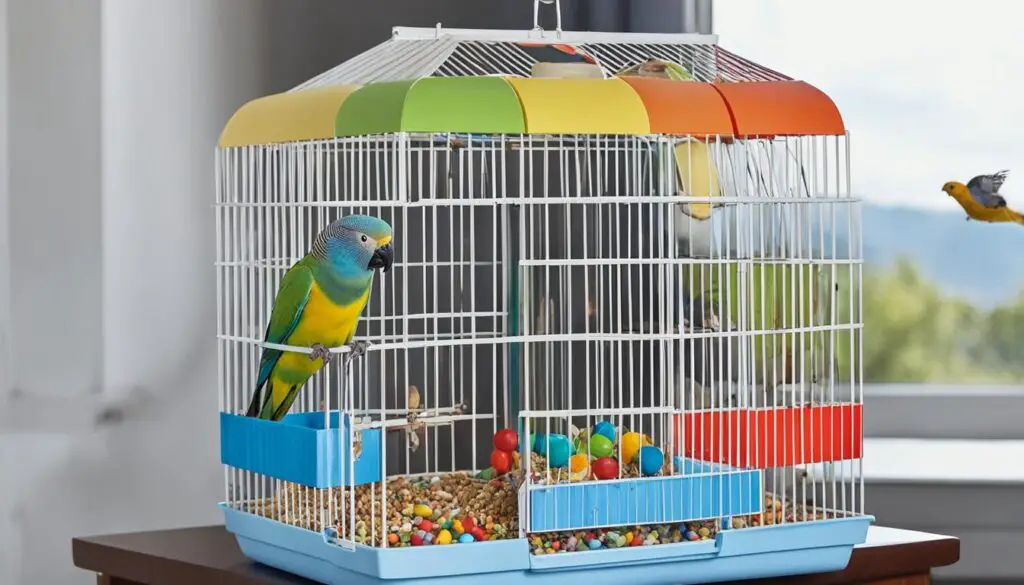Effective Communication Techniques with Parakeets

Building an effective communication bond with your parakeet is crucial for understanding their behavior and ensuring their well-being. As a parakeet owner, I have discovered a variety of techniques that can help establish a strong connection and enhance communication skills with these delightful birds. By employing these techniques, you can develop a deep understanding of your parakeet and strengthen the bond you share.
Key Takeaways:
- Effective communication is essential for understanding parakeet behavior.
- Parakeets primarily communicate through vocalizations, body language, and behavior signals.
- Understanding parakeet vocalizations can help you decipher their emotions and needs.
- Observing body language cues can provide valuable insights into your parakeet’s state of mind.
- Positive reinforcement training and a dedicated communication routine can further enhance your bond with your parakeet.
Understanding Parakeet Vocalizations
Parakeets have a wide range of vocalizations that they use to communicate their needs, emotions, and warnings. Understanding these vocalizations is key to strengthening the bond and communication between you and your parakeet.
The most common vocalization you’ll hear from your parakeet is chirping. Chirping can vary in intensity, from soft and melodic to loud and rapid. This vocalization is often an expression of contentment or a desire for attention.
Squawking, on the other hand, is a louder and more urgent vocalization. It usually indicates discomfort, fear, or a need for immediate attention. When you hear your parakeet squawking, it’s important to assess the situation and provide the necessary support or reassurance.
Trilling is another vocalization that parakeets use to express excitement or happiness. It’s a joyful and melodic sound that you may hear when your parakeet is enjoying its surroundings or feeling particularly playful.
By understanding the different types of vocalizations and their associated meanings, you can respond appropriately to your parakeet’s communication cues and deepen your connection with them. Paying attention to their vocalizations will enable you to provide the care and attention they need when they need it.
Parakeet Vocalizations and Meanings
| Vocalization | Meaning |
|---|---|
| Chirping | Contentment or a desire for attention |
| Squawking | Discomfort, fear, or a need for immediate attention |
| Trilling | Excitement or happiness |
Understanding parakeet vocalizations will enable you to better meet their needs and strengthen the bond you share. By responding appropriately to their vocal cues, you’ll create a harmonious and enriching environment for both you and your parakeet.
Body Language and Behavior Signals
In addition to vocalizations, parakeets also communicate through their body language and behavior. Observing these cues can provide important insights into their overall well-being and emotions.
One notable body language signal displayed by parakeets is fluffed feathers. When a parakeet fluffs its feathers, it often indicates relaxation or contentment. This can be observed when your parakeet looks relaxed and puffy, with its feathers fully extended. It’s a sign that your parakeet feels safe and comfortable in its environment.
Another behavior signal to pay attention to is a raised crest. When a parakeet’s crest is raised, it signifies excitement or curiosity. You may notice the feathers on top of its head standing upright, indicating that your parakeet is interested in something or feeling stimulated.
A wagging tail is yet another body language cue that parakeets use to communicate. If you observe your parakeet’s tail wagging back and forth, it often signifies playfulness or happiness. It’s a joyful expression and can be seen during playtime or when your parakeet is in a good mood.
Understanding these body language signals is essential for interpreting your parakeet’s emotions and needs accurately. By observing their fluffed feathers, raised crest, or wagging tail, you can respond appropriately and strengthen the bond of trust with your parakeet.

Positive Reinforcement Training
Positive reinforcement training is a highly effective technique for parakeet training, utilizing rewards to establish desired behaviors and strengthen the communication bond. By using rewards that parakeets find motivating and associating them with specific actions, positive reinforcement can encourage positive behaviors and facilitate effective communication.
One popular method of positive reinforcement training is clicker training. This technique involves using a clicker sound as a marker for desirable behavior, followed by a reward. The clicker serves as a consistent signal, helping parakeets understand what actions are being rewarded. With time and repetition, parakeets can associate the clicker sound with positive reinforcement, making communication smoother and more efficient.
When implementing positive reinforcement training, it is crucial to choose rewards that are highly valued by your parakeet. This can include their favorite treats, verbal praise, or even access to enjoyable activities, such as playtime outside of the cage. By offering rewards consistently and immediately after the desired behavior, you reinforce the connection between the action and the positive outcome, making it more likely to be repeated.
Consistency and patience are key when utilizing positive reinforcement training. It may take time for your parakeet to understand the associations between actions and rewards, so it’s important to remain consistent in your training approach. By providing clear cues, rewarding desired behaviors, and gradually increasing expectations, you can guide your parakeet towards the desired behavior and strengthen your communication bond.
“Positive reinforcement is an incredibly effective way to establish desired behaviors in parakeets. By using rewards to reinforce positive actions, we can strengthen the bond and improve communication with our feathered friends.” – Dr. Rachel Parker, Avian Behavior Specialist
Benefits of Positive Reinforcement Training:
- Promotes a positive and trusting relationship between you and your parakeet
- Facilitates effective communication by reinforcing desired behaviors
- Enhances your parakeet’s understanding of cues and commands
- Reduces the reliance on aversive training methods
- Encourages mental stimulation and engagement
By employing positive reinforcement training techniques, you can create an environment that fosters continuous learning, enhances communication, and strengthens the bond between you and your parakeet. Remember to always be patient, consistent, and attentive to your parakeet’s individual needs and preferences throughout the training process.
Creating a Communication Routine
Establishing a communication routine with your parakeet is essential for maintaining a strong bond and effectively understanding each other. By dedicating daily quality time to interact and engage with your feathered friend, you can nurture a deeper connection and enhance your communication skills.
During your daily interactions, it’s important to engage in activities that your parakeet enjoys. Whether it’s talking to them in a calm and reassuring tone, offering treats during training sessions, or providing mental and physical enrichment through toys and games, these interactions create positive experiences and strengthen your bond.
By consistently participating in a communication routine, you demonstrate your commitment to understanding your parakeet’s needs and preferences. This routine provides a sense of stability and security for your parakeet, allowing them to feel comfortable and more willing to communicate with you.
Remember to be patient and responsive during your communication routine. Pay attention to your parakeet’s cues and respond accordingly, providing them with the attention and enrichment they need to flourish. Through daily interactions and bonding time, you’ll deepen your understanding of each other and create a lifelong connection.

The Importance of Patience and Observation
Effective communication with parakeets requires patience and keen observation skills. Parakeets may not immediately respond to your cues or training efforts, and it’s important to remain patient and persistent. Each parakeet has its own unique personality and learning pace.
By observing their behavior, body language, and vocalizations, you can better understand their individual quirks and preferences. This will help you adjust your communication approach accordingly and address any communication challenges that may arise along the way.
Remember that building a strong communication bond takes time and effort, but the rewards are well worth it.
Patience is Key
When interacting with your parakeet, it’s important to recognize that they may require time to adjust and feel comfortable in their environment. Patience is key in allowing them to acclimate to new surroundings, routines, and your presence. Avoid rushing the process and respect their boundaries.
Furthermore, parakeets have unique personalities and may require varying amounts of time to respond to your training efforts. Some may quickly pick up on cues, while others may need more time to grasp certain commands or behaviors. It’s crucial to remain patient throughout the training process and avoid becoming frustrated or discouraged.
The Power of Observation
Observation plays a vital role in understanding your parakeet’s behavior and needs. By closely watching their actions, you can gain valuable insights into their emotions, preferences, and overall well-being.
Take note of their body language cues, such as the position of their feathers, crest, and tail. Fluffed feathers may indicate relaxation or contentment, while a raised crest could signify excitement or curiosity. Understanding these subtle signals will help you communicate more effectively and cater to their specific needs.
“Observation is the key to unlocking the secrets of parakeet communication. Their actions speak volumes; we just need to pay attention.”
Overcoming Communication Challenges
Communication challenges may arise when attempting to understand and communicate with your parakeet. They may exhibit behaviors that are difficult to interpret or display reluctance in responding to certain cues.
By combining patience and observation, you can address these challenges and find alternative ways to connect with your parakeet. Experiment with different training techniques, adjust your tone of voice, or offer rewards that are particularly enticing to your feathered companion.
The Rewards of Effective Communication
Developing a strong communication bond with your parakeet is a rewarding experience. It allows you to better meet their needs, understand their emotions, and enhance their overall well-being.
Through patience and observation, you’ll cultivate a deeper understanding of your parakeet’s unique personality and communication style. This will strengthen your relationship and create a harmonious living environment for both you and your feathered friend.
Conclusion
Effective communication techniques are crucial for building a strong bond with your parakeet and understanding their behavior. By paying close attention to their vocalizations, body language, and behavior signals, you can decode their needs and emotions more accurately. This understanding will enable you to provide the care and attention they require.
The incorporation of positive reinforcement training, combined with a consistent communication routine, can further enhance your ability to effectively interact with your parakeet. Positive reinforcement, such as rewards and clicker training, encourages desired behaviors and strengthens the communication bond between you and your feathered companion.
Patience and observation are key in developing effective communication with parakeets. Each parakeet has its own unique personality and pace of learning. By being patient and observant of their individual quirks and preferences, you can tailor your communication approach to their needs, effectively overcoming any challenges that may arise.
Remember, building a deep and meaningful communication bond takes time and dedication. By implementing these effective communication techniques, you’ll establish a strong connection with your parakeet, fostering a lifetime of companionship and understanding.
FAQ
How do parakeets communicate?
Parakeets primarily communicate through vocalizations, body language, and behavior.
What are some common vocalizations that parakeets use?
Parakeets commonly use chirping, squawking, and trilling to communicate their needs, emotions, and warnings.
How can I understand and respond to my parakeet’s body language?
Observing cues like fluffed feathers, raised crest, and wagging tail can provide insights into your parakeet’s well-being and emotions.
How can positive reinforcement training help improve communication with my parakeet?
Positive reinforcement training involves rewarding desired behaviors, which can strengthen the communication bond and encourage positive behaviors.
How can I establish a communication routine with my parakeet?
Dedicate daily quality time to engage in interactions, training sessions, and providing mental and physical enrichment for your parakeet.
Why is patience and observation important in communicating with parakeets?
Each parakeet has its own unique personality and learning pace, and being patient and observant helps adjust your communication approach accordingly.
What are the key elements of effective communication techniques with parakeets?
Key elements include understanding vocalizations and body language, positive reinforcement training, establishing a routine, and practicing patience and observation.



